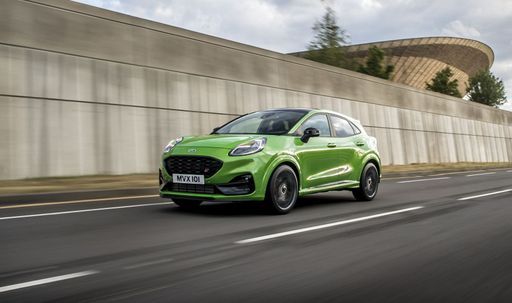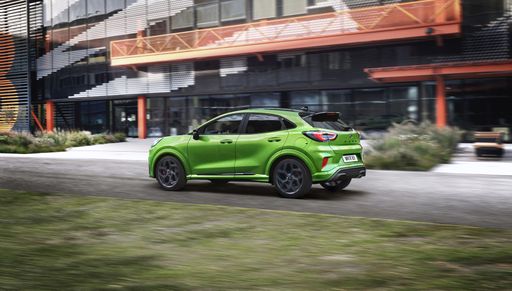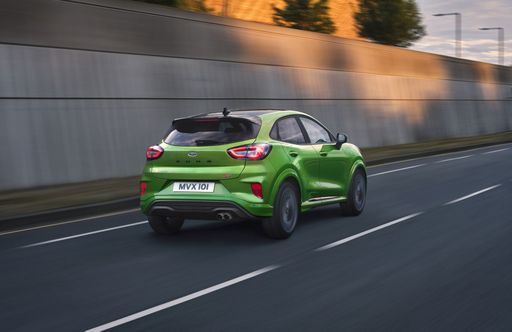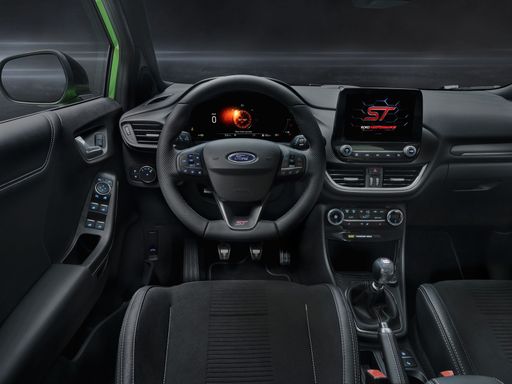Ford Puma vs Kia PV5 – Differences & prices compared
Compare performance, boot space, consumption and price in one view.
Find out now: which car is the better choice for you – Ford Puma or Kia PV5?
The Ford Puma (SUV) comes with a Petrol MHEV or Electric engine and Manuel or Automatic transmission. In comparison, the Kia PV5 (Cargo Van or Bus) features a Electric engine with Automatic transmission.
When it comes to boot capacity, the Ford Puma offers 523 L, while the Kia PV5 provides 1320 L – depending on how much space you need. If you’re looking for more power, decide whether the 168 HP of the Ford Puma or the 163 HP of the Kia PV5 suits your needs better.
In terms of consumption, the values are 13.10 kWh5.40 L per 100 km for the Ford Puma, and 19.80 kWh for the Kia PV5.
Price-wise, the Ford Puma starts at 24800 £, while the Kia PV5 is available from 32800 £. Compare all the details and find out which model fits your lifestyle best!
Ford Puma
The Ford Puma presents itself as a stylish compact SUV with a distinctive design that combines practicality with a dynamic driving experience. Its sleek lines and sporty aesthetics make it stand out on the road, while the interior offers a comfortable and tech-savvy environment. With an emphasis on efficiency and a smooth drive, the Ford Puma is well-suited for both urban commutes and countryside adventures.
details @ puma.fordpresskits.com
@ puma.fordpresskits.com
 @ puma.fordpresskits.com
@ puma.fordpresskits.com
 @ puma.fordpresskits.com
@ puma.fordpresskits.com
 @ puma.fordpresskits.com
@ puma.fordpresskits.com
Kia PV5
The Kia EV5 is an exciting new entrant in the landscape of electric SUVs, promising a blend of style and innovation that captures attention. It boasts a sleek and modern design that aligns with Kia's evolving aesthetic identity, blending practicality with eye-catching details. With its foray into the electric vehicle segment, the EV5 is set to offer a highly competitive option for those looking to embrace sustainable mobility without compromising on comfort or tech features.
details

|
|
|
|
|
Costs and Consumption |
|
|---|---|
|
Price
24800 - 36300 £
|
Price
32800 - 38900 £
|
|
Consumption L/100km
5.4 - 6 L
|
Consumption L/100km
-
|
|
Consumption kWh/100km
13.1 - 13.7 kWh
|
Consumption kWh/100km
19.8 - 20.3 kWh
|
|
Electric Range
364 - 376 km
|
Electric Range
288 - 400 km
|
|
Battery Capacity
43 kWh
|
Battery Capacity
51.5 - 71.2 kWh
|
|
co2
0 - 136 g/km
|
co2
0 g/km
|
|
Fuel tank capacity
42 L
|
Fuel tank capacity
-
|
Dimensions and Body |
|
|---|---|
|
Body Type
SUV
|
Body Type
Cargo Van, Bus
|
|
Seats
5
|
Seats
2 - 5
|
|
Doors
5
|
Doors
4 - 5
|
|
Curb weight
1316 - 1563 kg
|
Curb weight
1860 - 2145 kg
|
|
Trunk capacity
456 - 523 L
|
Trunk capacity
1320 L
|
|
Length
4186 - 4226 mm
|
Length
4695 mm
|
|
Width
1805 mm
|
Width
1850 - 1895 mm
|
|
Height
1550 - 1555 mm
|
Height
1923 mm
|
|
Payload
367 - 469 kg
|
Payload
505 - 790 kg
|
Engine and Performance |
|
|---|---|
|
Engine Type
Petrol MHEV, Electric
|
Engine Type
Electric
|
|
Transmission
Manuel, Automatic
|
Transmission
Automatic
|
|
Transmission Detail
Manual Gearbox, Dual-Clutch Automatic, Reduction Gearbox
|
Transmission Detail
Reduction Gearbox
|
|
Drive Type
Front-Wheel Drive
|
Drive Type
Front-Wheel Drive
|
|
Power HP
125 - 168 HP
|
Power HP
121 - 163 HP
|
|
Acceleration 0-100km/h
7.4 - 9.8 s
|
Acceleration 0-100km/h
10.7 - 16.3 s
|
|
Max Speed
160 - 210 km/h
|
Max Speed
135 km/h
|
|
Torque
170 - 290 Nm
|
Torque
250 Nm
|
|
Number of Cylinders
3
|
Number of Cylinders
-
|
|
Power kW
92 - 124 kW
|
Power kW
89 - 120 kW
|
|
Engine capacity
999 cm3
|
Engine capacity
-
|
General |
|
|---|---|
|
Model Year
2024 - 2025
|
Model Year
2025
|
|
CO2 Efficiency Class
D, E, A
|
CO2 Efficiency Class
A
|
|
Brand
Ford
|
Brand
Kia
|
Ford Puma
A Glimpse into the Ford Puma: Fusing Style with Innovation
The Ford Puma stands as a testament to modern engineering fused with style. This compact SUV is not just about aesthetics but brings to the table an array of technical innovations, topped with the reliability and performance Ford is known for. Let's delve into the technical specifics and innovative features that make the Ford Puma a stellar choice for any car enthusiast.
Powertrains and Performance
The Ford Puma is offered with a range of powertrains designed to deliver optimal performance whilst minimising fuel consumption. At the heart of this compact SUV is the 1.0 EcoBoost Hybrid engine, available in both 125 PS and 155 PS variants. This engine is a marvel of engineering, optimised to deliver power efficiently with a remarkable fuel consumption ranging from 5.4 to 5.7 L/100km for manual versions, and slightly higher for the automated variants.
The top-end 1.5 EcoBoost ST variant takes performance up a notch, providing a robust 200 PS that propels the Puma from 0 to 100 km/h in just 6.7 seconds. This variant is perfect for those who prioritise performance and exhilaration in their driving experience.
Mild-Hybrid Technology
The Puma's mild-hybrid technology plays a significant role in enhancing fuel efficiency and reducing emissions. By utilising a belt-driven integrated starter/generator, the Puma recovers energy usually lost during braking, storing it in a 48-volt lithium-ion battery. This stored energy is then used to assist the engine, providing a boost during acceleration and smoothing out the stop-start technology, ultimately leading to enhanced fuel efficiency.
Design and Comfort
The Ford Puma does not compromise on style and comfort with its ergonomic and stylish design. The SUV is available in multiple trims including the ST-Line, Titanium, and the luxurious Vignale editions, each offering unique aesthetic and technological enhancements. These trim levels provide varied offerings in terms of both exterior styling and interior comfort, ensuring there's a Puma that meets every personal preference.
Inside, the Puma offers a driver-focused cockpit with advanced technological integrations such as the SYNC 3 infotainment system, providing seamless connectivity and intuitive control of the vehicle's numerous technological features.
Safety and Technology
Safety remains paramount, and the Ford Puma is equipped with the latest security and technology features. It boasts the Ford Co-Pilot360 suite which includes adaptive cruise control, pre-collision assist with autonomous emergency braking, and lane-keeping assist, enabling a safer driving experience on both city roads and highways.
Versatility and Practicality
Beyond performance and safety, the Ford Puma shines in its versatility. With a boot capacity of 456 litres, it offers ample space for all sorts of adventures, whether you're heading on a family trip or loading sports equipment. Its innovative MegaBox is an extra storage solution, providing additional space below the boot floor.
The Puma's agile handling, paired with its compact dimensions—spanning a length of 4186 to 4266 mm and a width of 1805 mm—makes it an ideal choice for urban commuting and beyond.
Conclusion
In conclusion, the Ford Puma beautifully blends practical features with cutting-edge technology, offering a package that appeals to both the tech-savvy driver and those seeking comfort and reliability. Its range of innovative features, powerful yet efficient engine options, and a design that is both functional and stylish make it a frontrunner in the compact SUV market.
Whether you're drawn by the efficient mild-hybrid engines or the robust performance of the ST variant, the Ford Puma represents a modern driving experience where innovation meets everyday usability.
Kia PV5
A Fresh Perspective on Cargo Vans: The Kia PV5
The Kia PV5 stands as a beacon of innovation in the realm of electric cargo vans. Known for its forward-thinking design and practicality, this model sets a new standard in its class. The PV5 combines cutting-edge technology with an eco-friendly design, redefining the expectations for businesses seeking sustainable transportation solutions.
Electric Power Meets Efficiency
At the heart of the Kia PV5 lies an advanced electric powertrain. The model is equipped with a 51.5 kWh battery, offering an impressive electric range of 291 km on a single charge. This robust power supply pairs with a front-wheel-drive system powered by an electric motor that delivers 121 HP (equivalent to 89 kW), keeping the operations both smooth and efficient.
Sustainability Without Compromise
The commitment to sustainability is evident in the PV5’s zero emissions, with a CO2 output of 0 g/km. The van maintains a CO2 Efficiency Class of A, clearly demonstrating Kia’s dedication to reducing the environmental impact of its vehicles. Businesses adopting the PV5 can confidently promote their green credentials while benefiting from the cost savings associated with electric driving.
Designed for Modern Business Needs
The Kia PV5 Cargo L2H1 Electric Automatic model is engineered for functionality and ease of use. Its spacious design accommodates two seats and offers a generous cargo area, making it perfect for diverse delivery needs. The van spans 4695 mm in length, 1850 mm in width, and 1923 mm in height, providing ample space to maneuver goods with ease.
Performance and Practicality
In terms of performance, the PV5 boasts a torque of 250 Nm and can accelerate from 0 to 100 km/h in 16.3 seconds. While its top speed is capped at 135 km/h, this is more than sufficient for urban and suburban delivery routes. The reduction gearbox ensures smooth transitions as it navigates through daily tasks.
Safety and Innovation
Safety is not compromised with the Kia PV5. It features a suite of safety technologies that support the driver in maintaining control and avoiding incidents. These innovations not only contribute to the safety of the driver and cargo but also offer peace of mind to businesses that prioritize the wellbeing of their workforce and goods.
The Road Ahead for Kia PV5
As the automotive industry continues to move towards electrification, the Kia PV5 exemplifies how cargo vans can adapt to this change seamlessly. It represents an essential step towards more sustainable business operations, providing a viable and efficient option for companies looking to reduce their carbon footprint while enhancing operational efficiency. The Kia PV5 is more than just a vehicle; it’s a strategic asset for any forward-thinking business.
The prices and data displayed are estimates based on German list prices and may vary by country. This information is not legally binding.
